#nuestra señora de lumen
Photo
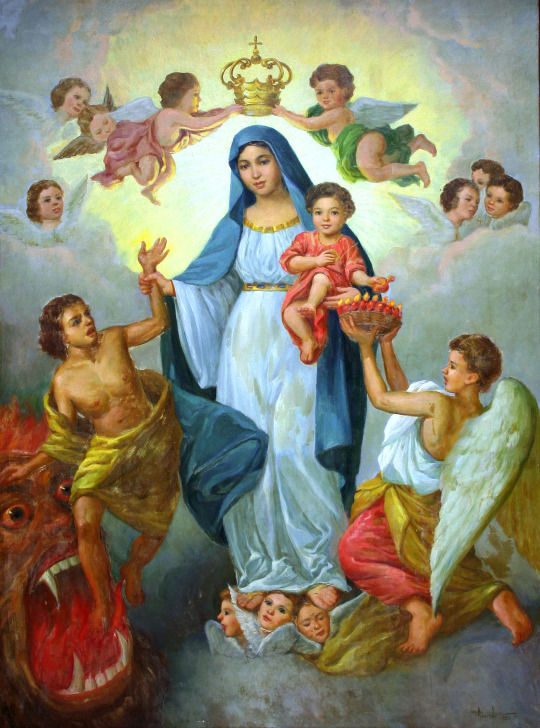
THE DESCRIPTION OF OUR LADY OF LIGHT
Feast Day: December 1 (primary) Thursday after Pentecost
She is the light that shines through the darkness.
In the historic town of Cainta, Rizal, there is this Marian shrine where pilgrims from all over the country flock to venerate this unique Marian image in the country - the miraculous of the image of Nuestra Señora de la Lumen (Our Lady of Light). This image of Our Lady was one of a kind venerated image in the country for this image was painted by a renowned National Artist, Fernando Amorsolo, and it is considered his only masterpiece that is venerated and miraculous by the people of Cainta.
The image of Our Lady of Light of Cainta was based on the original image venerated in Palermo, Sicily and Guanajuato, Mexico. The image was that of a canvas painting where the Virgin was depicted holding her Son Jesus. The Virgin is preventing a soul from the flaming mouth of Satan while an angel was holding a basketful of hearts and offering it to the Child Jesus while the Child Jesus accepts these offerings of flaming hearts, the hearts of the faithful. Two cherubs hover above the Virgin and they are about to crown the Blessed Virgin Mary.
This depiction was based on an apparition of a pious woman in Palermo, Sicily in 1722 and upon the advice of Fr. Giovanni Genovesi, a Jesuit priest, the original painting was commissioned based on the woman's vision for the purpose of his missionary work in the Island.
The devotion to Nuestra Señora de la Lumen originated in the island of Sicily, South of Italy sometime in 1722 when a pious woman, with a good reputation of holiness and piety, was reported to receive visions of the Blessed Virgin Mary and reported these visions to Rev. Fr. Giovanni Antonio Genovesi, a Jesuit priest. Fr. Genovesi at that time, wanted an image of the Virgin that would help him in his mission in Sicily. When the pious lady relayed these to Fr. Genovesi, he requested the lady to ask the Blessed Mother for her guidance in this pious desire of having a beautiful image of her. The Virgin granted this request when she appeared once again to the lady on November 21, 1722. The Virgin also requested that she wanted to be known as 'Madre Santissima del Lume (Mother of Light)'.
Despite the hardships that the lady and Fr. Genovesi to complete the painting of the Virgin, the painting was complete in. It is also interesting to note that while the painter is painting the image, the Blessed Virgin was present at the painter's studio, however, only the pious woman can only see her, yet the Blessed Mother and the visionary guided the painter on completing the image and the result was a beautiful image of Our Lady of Light, it was very beautiful that it is said that the painter could not replicate this heavenly masterpiece.
The image accompanied Fr. Genovesi during his missionary work until his death. Each time the people of a certain place would know that he and the picture were coming, they would wholeheartedly prepare their chapel or church, and the altar on which the holy picture was always met by many people holding flowers or lighted candles. The original image was unfortunately destroyed in 1943 when the Church in Casa Profesa was bombed. The image of the Confraternity was Canonically Crowned in the Cathedral of Palermo in 1986.
Through the help of the Jesuit Missionaries, the devotion to Our Lady of Light spread throughout Europe and Latin America. A confraternity, called Confraternita Della Madonna del Lume al Noviziato, was founded to further propagate the devotion that was formed in 1736 and Pope Clement XXII authorized the veneration of the Blessed Virgin under this title. The devotion became very popular in Italy with numerous copies of the image that can be found in that country and venerated by the faithful through the centuries.
The devotion later reached Mexico and Latin America through the efforts of the Jesuit order. The devotion in Mexico began in 1732 when Rev. Fr. Giuseppe Maria Genovese, believed to be a relative of Fr. Giovanni Antonio Genovesi, began to preach the Gospel in the Spanish colony while propagating the devotion to the Blessed Sacrament and Our Lady of Light. He later established shrines dedicated to the Virgin of Light which became pilgrimage sites over the years. A faithful copy of the image was enshrined by Fr. Genovese at the Church in Leon, Guanajuato, Mexico, and became the center of devotion in Mexico and this image was canonically crowned in 1902.
The popularity of the Virgin of Light was so widespread that the other religious orders, like the Franciscans, also began to promote the devotion in Mexico and later carried it over to the Philippines, most specifically in Joroan. While the devotion becomes more popular, controversy arises when some members of the clergy questioned the depiction of the Virgen de la Lumen, most specifically when the Virgin pulled a soul from the mouth of the devil, which they believed that it contradicts the teaching that Christ is our only Savior. For some time, the devotion was halted and its effects were felt when later images of the Virgin is depicted without the mouth of the beast, the Angel with a basket of hearts and the soul and was later replaced with a scepter and a rosary in place of the soul. The dispute ended in 1771 when a Franciscan friar points out that the Virgin was actually helping the soul from falling away to the fires of hell and the devotion resumed with much enthusiasm.
The devotion of Nuestra Señora de la Lumen arrived in the Philippines in two ways, first through the Jesuits in Cainta, Rizal in 1727 and in Loon, Bohol in 1754 under the title Nuestra Senora de la Luz and second through the Franciscan Friars in Albay under a different title, Nuestra Señora de Salvacion in 1776.
The Jesuit missionaries arrived in Cainta in 1591 and introduced the devotion to Nuestra Senora de la Lumen in 1727, a few years after the beginning of the devotion in Sicily through the efforts of Rev. Fr. Bartolommeo Cavanti, SJ who came from Ferrara, Italy by which the devotion became widespread in Italy at that time.
The original image that was brought by the Jesuits was first enshrined in one of the side altars of the Parish until its transfer to the main altar in 1853. Unfortunately, the original image was destroyed during the Philippine Revolution in 1899, nevertheless, there were two existing copies of the original image that was venerated in the meantime, an illustrated estampa that was printed in 1801 which was usually given to families who give donations to Our Lady and some of the copies exists to some residences in Cainta. Another copy of the image was a charcoal painting by Mariano Javier of Cainta which was done in 1857 with some similarities with the Verdadero Retrato estampa and at present, it is kept by the heirs of the late Mrs. Flora Javier Buenviaje.
The present image of Nuestra Senora de la Lumen was commissioned in 1950 by Fr. Joseph Flameygh, CICM, then parish priest of Cainta, to National Artist Fernando Amorsolo based on a prayer card that it is believed to have come from Guanajauto, Mexico. The image was painted in a very unique way for the faces of the Virgin, the Child, the Angels, and the soul to have Filipino features. The image was initially enshrined in a semi-concrete provisional chapel then later to her permanent altar in the reconstructed church of Cainta in 1968. The image later undergo an 'artistic conservation' in 2007 and was later enthroned to her renovated altar that same year.
The devotion to the Virgin of Light became very popular in Cainta that as the devotion was so widespread, she became the Secondary Patroness of Cainta, with St. Andrew as its Titular Patron. Years later, with the publication of the first Tagalog novena to Our Lady of Light in 1884, Our Lady was considered as the Titular Patron of the Parish and the Town of Cainta.
In the line of the 285th anniversary of the arrival of the devotion to Nuestra Señora de la Lumen by the Jesuits, the miraculous image was granted the honor of Episcopal Coronation on November 7, 2012 by Bishop Emeritus Gabriel Reyes, DD and the Coronation rites were performed on December 1, 2012, the Feast of Our Lady of Light of Cainta. Five years later, the Congregation of the Divine Worship and the Discipline of the Sacraments granted the Pontifical Coronation of the image on December 6, 2017, and the Coronation rites were performed on December 1, 2018. The coronation rites coincided with the declaration of the parish as a Diocesan Shrine.
The devotion to Nuestra Señora de la Lumen of Cainta was engrained in the popular consciousness of the people of Cainta, Rizal for centuries due to the many miracles that she wrought for the town. The feast of Nuestra Señora de la Lumen of Cainta was celebrated on December 1, a day after the Feast of St. Andrew the Apostle, the second patron of Cainta, since 1853. The Virgin also celebrates her Secondary Feast which is celebrated every Thursday after Pentecost Sunday. The devotees of Nuestra Señora de la Lumen also observe the Seven Saturday (Siete Sabados) novena preceding her feast day in December. She is well known as the patroness of reconciliation and those seeking conversion.
The devotion to Nuestra Señora de la Lumen is one of the most popular and unique devotions to Our Lady in the Philippines for through her image, she communicated to us that she is there, helping us along the way, to lead us to her Son, the Savior of Mankind and Light of the World.
#random stuff#catholic#our lady of light#nuestra señora de la luz#nuestra señora de lumen#madre santissima del lume
3 notes
·
View notes
Text
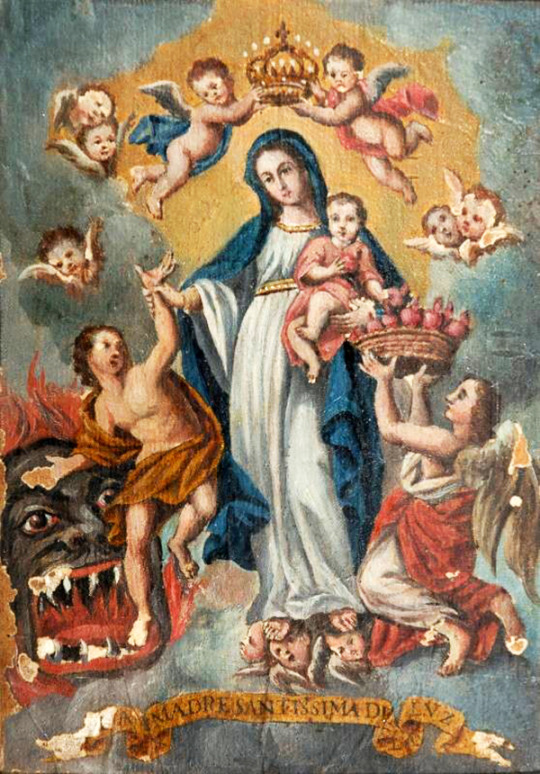
LA MADRE SANTISSIMA DE LA LUZ
#ave maria#maria#mary#birheng maria#virgen maria#virgin mary#blessed virgin mary#inang maria#mama mary#ina ng kaliwanangan#nuestra señora de la luz#nuestra señora de la lumen#our lady of light
6 notes
·
View notes
Text

Colonized Sexuality
Luiza Prado
2013
Medio: Fotografía
Es una fotografía cargada de símbolos gráficos alusivos a las construcciones occidentales referentes a la menstruación, estigmas que específicamente son vistos como impuros e indecorosos por la religión católica instaurada en Latinoamérica gracias a la colonización, en colonized sexuality Luiza crítica estas concepciones construyendo un icono religioso como es la cruz para el catolicismo con toallas menstruales y sangre, ambos elementos considerados “obscenos” puesto que las personas menstruantes en especial si son mujeres no deben apropiarse de este tema deben permanecer inmaculadas y obedientes, el lugar propuesto para su manifestación fue la Parroquia Basílica Nuestra Señora de la Candelaria (construcción colonial de 1776) puesto que es un espacio creado para la devoción de la virgen, una figura del catolicismo proclamada como “modelo y figura de la Iglesia, en el orden de la fe, la caridad y la perfecta unión con Cristo”. (Lumen gentium, 63)
(cuerpo-clase-privatización)
0 notes
Text
Horarios e itinerarios de la Procesión Magna de Almería «Lumen Dei in Aeternum» 29 de Octubre del 2022
Horarios e itinerarios de la Procesión Magna de Almería «Lumen Dei in Aeternum» 29 de Octubre del 2022
Todos los Datos con Bandas, Horarios e Itinerarios de la Procesión Magna de Almería «Lumen Dei» el 29 de Octubre del 2022
NUESTRO PADRE JESÚS DE LA VICTORIA
Ilustre Hermandad del Niño Jesús del Remedio y Cofradía de Nuestro Padre Jesús de la Victoria en su Entrada Triunfal en Jerusalén y Nuestra Señora de la Paz
Hora de salida del templo: 16:40 horas
Hora de entrada en carrera oficial (Paseo…
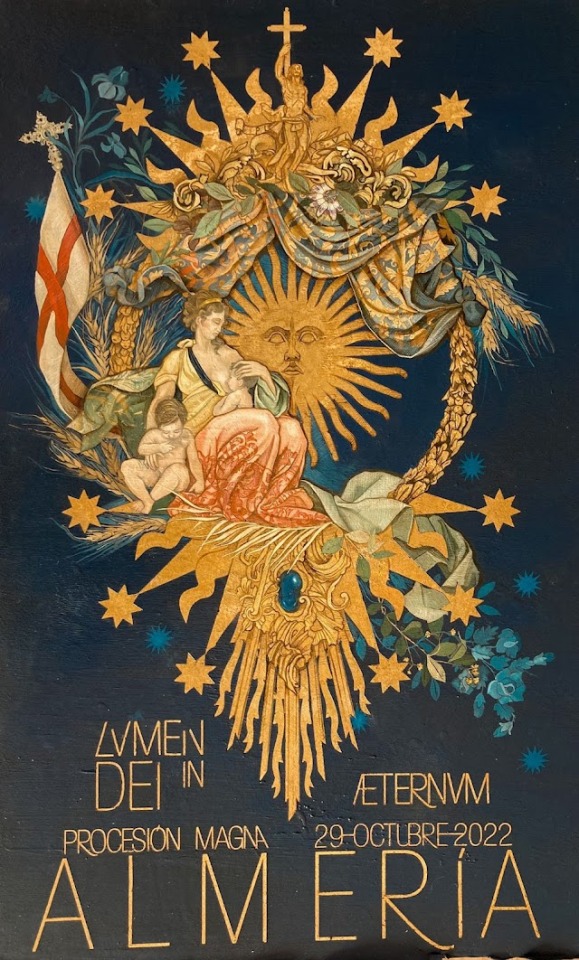
View On WordPress
0 notes
Photo

8 de Diciembre
Día de la VIRGEN MARÍA
La Virgen, “la Madre de Dios y Madre espiritual nuestra”, es sin duda la criatura en la que la imagen de Dios se refleja con una claridad absoluta, sin ofuscación alguna, como sucede, sin embargo, con cualquier otra criatura humana. ¿No puede comenzar nuestro trabajo en este mundo de paso, sin fijar nuestra mirada en esta mujer humilde, nuestra Hermana y al mismo tiempo nuestra Madre celeste, espejo nítido y sagrado de la infinita Belleza? Por este motivo, como laico, quisiera en este día tan especial, dar gracias a la Virgen santísima y dirigirme a ella con los mismos sentimientos que animaron a los padres conciliares, quienes dedicaron precisamente a María el último capítulo de la constitución dogmática “Lumen gentium”, subrayando la inseparable relación que une a la Virgen con la Iglesia. Sí, queremos darte gracias, Virgen Madre de Dios y Madre nuestra queridísima, por tu intercesión a favor de la Iglesia. Tú que, al abrazar sin reservas la voluntad divina, te consagraste con todas tus energías a la persona y a la obra de tu Hijo, enséñanos a guardar en el corazón y a meditar en silencio, como tú lo hiciste, los misterios de la vida de Cristo. Tú que avanzaste hasta el Calvario, estando siempre profundamente unida a tu Hijo, que sobre la cruz te entregó como madre al discípulo Juan, haz que todos experimentemos tu cercanía en todo instante de la existencia, sobre todo en los momentos de oscuridad y de prueba. Tú, que en Pentecostés, junto a los apóstoles reunidos en oración, imploraste el don del Espíritu Santo para la Iglesia naciente, ayúdanos a perseverar en el fiel seguimiento de Cristo. Dirigimos nuestra mirada con confianza hacia ti, “signo de esperanza cierta y de consuelo, hasta que venga el día del Señor”. María, a ti te invocan con súplica insistente los fieles de todas las partes del mundo para que, ensalzada en el cielo entre los ángeles y los santos, intercedas por nosotros ante tu Hijo, “para que las familias de todos los pueblos tanto los que se honran con el nombre de cristianos, como los que aún ignoran al Salvador, sean felizmente congregados con paz y concordia en un solo Pueblo de Dios, para gloria de la Santísima e indivisible Trinidad”. Protege Señora Nuestra, al mundo entero y en especial a nuestro País que comenzara en días un nuevo periodo de gobierno.
Dr. Jorge Bernabé Lobo Aragón
#Argentina #Tucumán
2 notes
·
View notes
Text
Our Lady Of Light Church
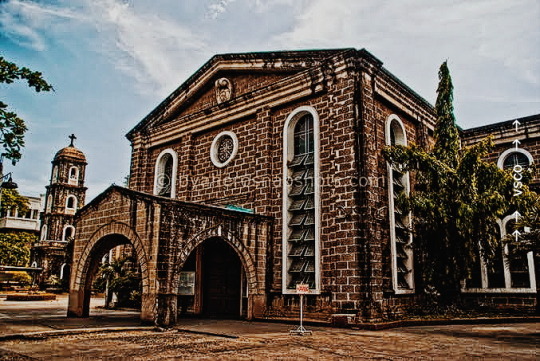
The Diocesan Shrine and Parish of Our Lady of Light, popularly known as Cainta Church (Spanish: Parroquia de Nuestra Señora de la Luz), is a Roman Catholic parish church located along Andres Bonifacio Avenue in Barangay San Andres, Cainta, Rizal in the Philippines. The church also operates a neighboring school, Cainta Catholic College. From its time of erection as a parish in 1760 until 1983, it belonged to the Archdiocese of Manila. It was placed under the newly created Diocese of Antipolo in 1983, which is now headed by Most Rev. Francisco M. De Leon. It belongs to the Vicariate of Our Lady of Light.
The original church of Cainta was first constructed in stone by Father Gaspar Marco, a Jesuit priest in 1707. The shrine at the time was under the patronage of Saint Andrew the Apostle. The construction of the stone church was designed by Father Juan de Salazar, S.J. and was completed during the time of Joaquin Sanchez, S.J. in 1716 while he was still the parish priest.
In 1727, a painting of Our Lady of Light was brought in from the Kingdom of Sicily and was chosen as the new patroness of the church. By 1760, the church was officially declared a separate parish.
On 23 February 1853, an earthquake damaged the church building while both its ts roof and one wall collapsed while the walls of the parish rectory or convent sustained cracks.
By 1884, the parish was already named as Our Lady of Light (Virgen ng Caliuanagan or Madre Santissima del Lumen in Tagalog and Spanish languages), as attested on the 5 August 1884 letter by the pastor of Cainta Don Mariano de San Juan to the Archbishop of Manila, Fray Pedro Payo,
0 notes
Photo

http://www.bloodycross.net/
Italia,época actualLas criaturas sobrenaturales aún permanecen en las sombras, pero cada día hay más seres y sucesos empeñados en que el velo se descorra. Las mafias están buscando controlarlo todo, y pese a que la conocida familia Giovanni es la más poderosa, los nuevos grupos han teñido toda la ciudad con sus actos violentos; ni el departamento de policía ni el presidente, han podido frenarlos. Los hilos se van tejiendo de múltiples formas y en la reconocida Universidad de Nuestra señora de Lumen se han colado éstos seres -previos acuerdos con la dirección-. Las logias y un extraño culto posiblemente satánico también se han hecho presentes, y las desapariciones de estudiantes han alarmado a todo el mundo. En el mundo de los vampiros y los lobos, la guerra ha sido declarada y los atentados terroristas alrededor del mundo son el anuncio de que la guerra mundial que se avecina. Nadie estará a salvo...
3 notes
·
View notes
Text
NATIVIDAD DE LA VIRGEN MARÍA: Dios prepara la Maternidad Divina de María
Dios planeó desde toda la eternidad toda la obra admirable de la Encarnación del Verbo como culminación de la creación del Universo; y como quiera que en la mente sapientísima de Dios cabía simultáneamente la previsión del mal del hombre y de su restauración por medio del mismo verbo revestido de carne mortal, dentro de toda esta visión divina estaba también con preponderante papel, la persona y la misión de María Madre del Verbo hecho carne. Así, pues, la razón misma de ser de la Virgen María estaba en los designios del Altísimo aun antes del tiempo, en su carácter de Madre del Verbo Encarnado.
Nosotros pensamos y proyectamos, pero muchas veces nuestros proyectos, por hermosos y hacederos que parezcan, permanecen en la ineficacia; no ocurre así con Dios, cuyo poder no tiene límites. De ahí que, al pensar Dios desde toda la eternidad en María, Madre de su Hijo Unigénito hecho carne, confiera a esta elegida un carácter muy específico para su existencia. Por eso podemos concluir que la elección de María no es el escoger una persona determinada para una misión específica, sino la predestinación desde antes de los siglos de una Madre para Jesucristo.
La liturgia de la Iglesia dedica con insistencia a la Madre del Señor en sus festividades los textos de los libros sapienciales en los que aparece la Sabiduría, o la Esposa, en la mente de Dios desde antes de los tiempos:
"Desde el principio y antes de los siglos me creó, y para la eternidad viviré " (Ecl 24, 9)
"Yahvé me creó en el comienzo de sus designios, antes de sus obras más antiguas. Desde la eternidad fui constituida, desde el comienzo, antes del origen de la tierra."
"Cuando el abismo no existía, fui yo engendrada, cuando no había fuentes ricas en aguas. Antes que los montes fueran fundados, antes de las colinas fui yo engendrada " ( Prov 8, 22-25 )
Estas expresiones son aplicables a la Madre de Dios.
En la Bula "Ineffabilis Deus" de Pío IX leemos cómo "El Dios inefable, habiendo previsto desde toda la eternidad la lastimosísima caída de todo el género humano por la trasgresión de Adán, decretó la primera obra de su bondad en el misterio oculto desde los siglos, por medio de la encarnación del Verbo.
"Es pues, la elección y predestinación de María algo íntimamente unido al decreto de la Redención que había de realizarse por el Verbo tan unido, que, concluye el Papa Pío IX, el destino de la Virgen fue preestablecido en un mismo decreto con la Encarnación de la Divina Sabiduría."
Esta predestinación de Nuestra Señora, desde la eternidad, para ser Madre de Dios, empieza a realizarse con el tiempo. He aquí cómo lo expresa el Concilio Vaticano II:
" El benignísimo y sapientísimo Dios, al querer llevar a término la redención del mundo, cuando llegó la plenitud del tiempo, envió a su Hijo hecho de mujer... para que recibiésemos la adopción de hijos (Gál 4 4-5)
El cual por nosotros, los hombres, y por nuestra salvación descendió de los cielos, y se encarnó por obra del Espíritu Santo de María Virgen." (Credo de la Misa: Símbolo de Constantinopla)
Este misterio divino de salvación se nos revela y continúa en la Iglesia, a la que el Señor constituyó como su Cuerpo y en ella los fieles, unidos a Cristo, su Cabeza, en comunión con todos sus santos, deben también venerar la memoria "en primer lugar, de la gloriosa siempre Virgen María, Madre de nuestro Dios y Señor Jesucristo" (Canon de la Misa. Concilio Vaticano II: Constitución Apostólica "Lumen Gentium", capítulo VIII n.52)
Fuente Aci Prensa
0 notes
Text
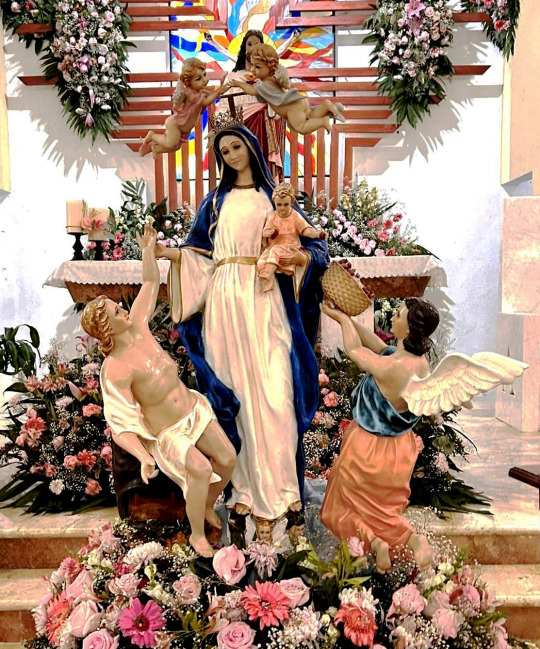
VIRGEN DE LA LUZ
#ave maria#maria#mary#birheng maria#virgen maria#virgin mary#blessed virgin mary#inang maria#mama mary#ina ng kaliwanangan#nuestra señora de la luz#nuestra señora de la lumen#our lady of light
4 notes
·
View notes
Text
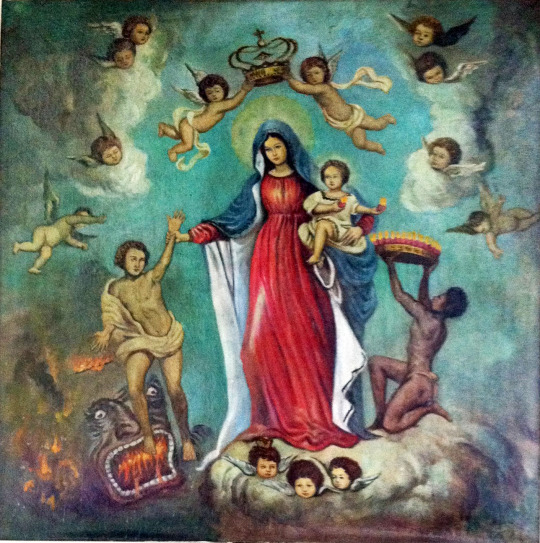
OUR LADY OF LIGHT
Mula sa Sacred Heart Novitiate
Novaliches, Lungsod Quezon
#ave maria#maria#mary#birheng maria#virgen maria#virgin mary#blessed virgin mary#inang maria#mama mary#ina ng kaliwanangan#inang santisima ng kaliwanangan#madre santissima del lume#nuestra señora de la luz#nuestra señora de la lumen#our lady of light#birhen ng cainta#virgen de cainta#virgin of cainta
1 note
·
View note
Text
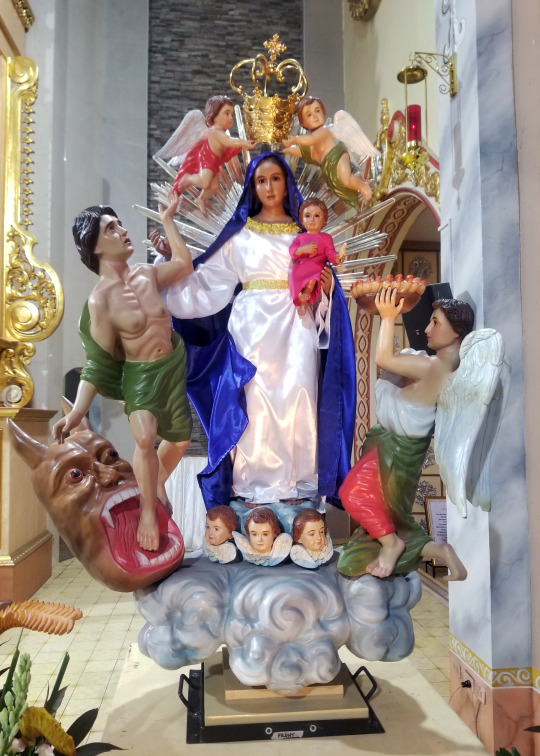
MAHAL NA INA NG KALIWANAGAN
Inukit ni Ian Vicente
#ave maria#maria#mary#birheng maria#virgen maria#virgin mary#blessed virgin mary#inang maria#mama mary#ina ng kaliwanangan#nuestra señora de la luz#nuestra señora de la lumen#our lady of light#ian vicente
2 notes
·
View notes
Text
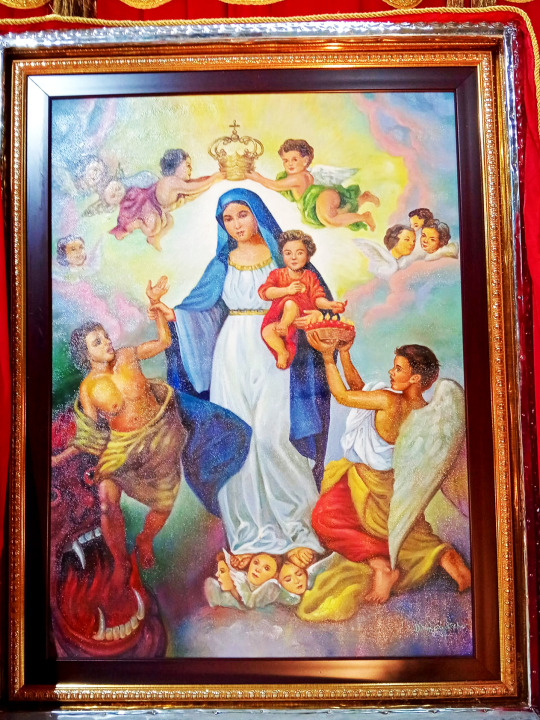
INANG SANTISIMA NG KALIWANAGAN
Ipininta ni Leonardo Landicho
#ave maria#maria#mary#birheng maria#virgen maria#virgin mary#blessed virgin mary#inang maria#mama mary#ina ng kaliwanangan#inang santisima ng kaliwanangan#madre santissima del lume#nuestra señora de la luz#nuestra señora de la lumen#our lady of light#birhen ng cainta#virgen de cainta#virgin of cainta#leonardo landicho
0 notes
Text

INANG SANTISIMA NG KALIWANAGAN
SumBingTik Festival 2023
#ave maria#maria#mary#birheng maria#virgen maria#virgin mary#blessed virgin mary#inang maria#mama mary#ina ng kaliwanangan#inang santisima ng kaliwanangan#madre santissima del lume#nuestra señora de la luz#nuestra señora de la lumen#our lady of light#birhen ng cainta#virgen de cainta#virgin of cainta#olightcainta#sumbingtik#sumbingtik festival#coronadaPHL#pontificiaPHL
0 notes
Text

Ang Ating INA NG KALIWANAGAN
Ipininta ni Daryll Hao Tudela
akriliko sa kambas, 2018
#ave maria#maria#mary#birheng maria#virgen maria#virgin mary#blessed virgin mary#inang maria#mama mary#ina ng kaliwanangan#inang santisima ng kaliwanangan#madre santissima del lume#nuestra señora de la luz#nuestra señora de la lumen#our lady of light#birhen ng cainta#virgen de cainta#virgin of cainta#daryll hao tudela
1 note
·
View note
Text

MAHAL NA INA NG KALIWANAGAN
Camarero: John Kenneth Lugay
#ave maria#maria#mary#birheng maria#virgen maria#virgin mary#blessed virgin mary#inang maria#mama mary#ina ng kaliwanangan#nuestra señora de la luz#nuestra señora de la lumen#our lady of light#birhen ng cainta#coronadaPH#coronadaPHL#pontificiaPH#pontificiaPHL#john kenneth lugay
1 note
·
View note
Text
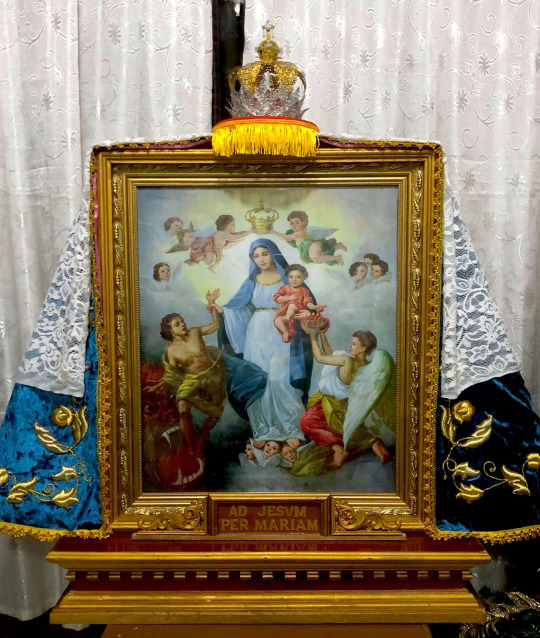
NUESTRA SEÑORA DE LA LUMEN
Camarero: Maui Lincolin Bernardo
#ave maria#maria#mary#birheng maria#virgen maria#virgin mary#blessed virgin mary#inang maria#mama mary#ina ng kaliwanangan#nuestra señora de la luz#nuestra señora de la lumen#our lady of light#birhen ng cainta#coronadaPH#coronadaPHL#pontificiaPH#pontificiaPHL#maui lincoln bernardo
0 notes